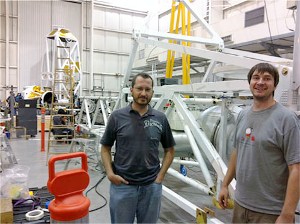Sep 16 2013
In a few days, a balloon-borne telescope sensitive to the polarization of high-energy “hard” X-rays will ascend to the edge of the atmosphere above Fort Sumner, N.M., to stare fixedly at black holes and other exotic astronomical objects.
 The X-ray telescope InFOCuS in the NASA hangar at the Fort Sumner Municipal Airport. An X-ray mirror (the object in the background, left, that looks like a jet engine intake) concentrates X-rays onto the WUSTL polarimeter, situated directly behind Matthias Beilicke (left) and Fabian Kislat.
The X-ray telescope InFOCuS in the NASA hangar at the Fort Sumner Municipal Airport. An X-ray mirror (the object in the background, left, that looks like a jet engine intake) concentrates X-rays onto the WUSTL polarimeter, situated directly behind Matthias Beilicke (left) and Fabian Kislat.
When X-Calibur, as the polarimeter is called, looks to the skies, it will see things that have never been seen before because it is looking at characteristics of high-energy light that astronomers are just beginning to explore.
X-Calibur differs from other instruments in that it can measure the polarization degree and direction of X-rays, which provide information not available in other ways. For example, when it looks at black holes and their plasma outflows, it will be able tos study how black holes devour matter and grow.
“Whenever you look at the sky at a different wavelength, you see something completely different,” said Henric Krawczynski, PhD, professor of physics in Arts & Sciences at Washington University in St. Louis and principal investigator of the X-Calibur experiment.
The beauty of balloon flights is that they can be used to test new instruments like X-Calibur at relatively low cost, but the drama of them is that the experiment flies at the mercy of the wind.
X-Calibur, like other experiments flown from NASA’s Columbia Scientific Balloon Facility in Fort Sumner, has to catch a ride on what is called a stratospheric turnaround event.
At mid-latitudes, stratospheric winds reverse direction twice each year: in the early spring and in late summer. When this happens, the winds are generally slow and small cells form where they go in circles. Balloons launched in these windows don’t fly far away and may actually circle back toward the launch area.
“This way you can put it in the air for 30 hours, if you’re lucky,” Krawczynski said. If they miss the stratospheric turnaround, however, the balloon flight could be cut short. When balloons drift outside the allowed operational area, flight safety officers fire guillotines that separate the parachute from the balloon, dropping the payload.
What could possibly go wrong?
The WUSTL polarimeter will be carried aloft by an X-ray pointing telescope, called InFOCuS, that was designed and built by NASA’s Goddard Space Flight Center.
A team of 15 people is working 12-hour days — essentially living in the NASA hangar at Fort Sumner — to make sure the telescope will be ready on time to catch the favorable winds.
One crucial task is to make sure the X-rays are concentrated on the center of the polarimeter, which is 8 meters from the mirror. The two components have to be aligned within one-sixtieth of a degree or the X-rays either won’t hit the collimator at the center of the polarimeter or they’ll hit it off-axis, both of which impact the results, Krawczynski said.
“The X-rays are hitting the collimator but a bit off to one side. We still need to tilt the mirror by half an arc-minute or so to focus the beam on the center of the collimator,” he said.
Everything else has to be carefully checked out as well. A reaction wheel that has worked for 25 years has suddenly started to wobble and must be replaced. And difficulties arose when the telescope was rotated through 90 degrees in the NASA hangar that hadn’t been apparent when it was rotated through 30 degrees in the lab.
But in fact, Krawczynski isn’t so much worried as excited. “When something doesn’t work, we have to troubleshoot and try to figure out what to do. It’s detective work, which is fun,” he said.
“I’m pretty confident we’ll make the window for these turnaround flights,” he said during a brief return to St. Louis. “It looks like we’ll be ready in the middle of the window, but maybe we can make up a few days’ time.”
Armchair observers can watch near-real-time video of the launch at the Columbia Scientific Balloon Facility. While the balloon is aloft, it will be tracked on a Google Earth map.